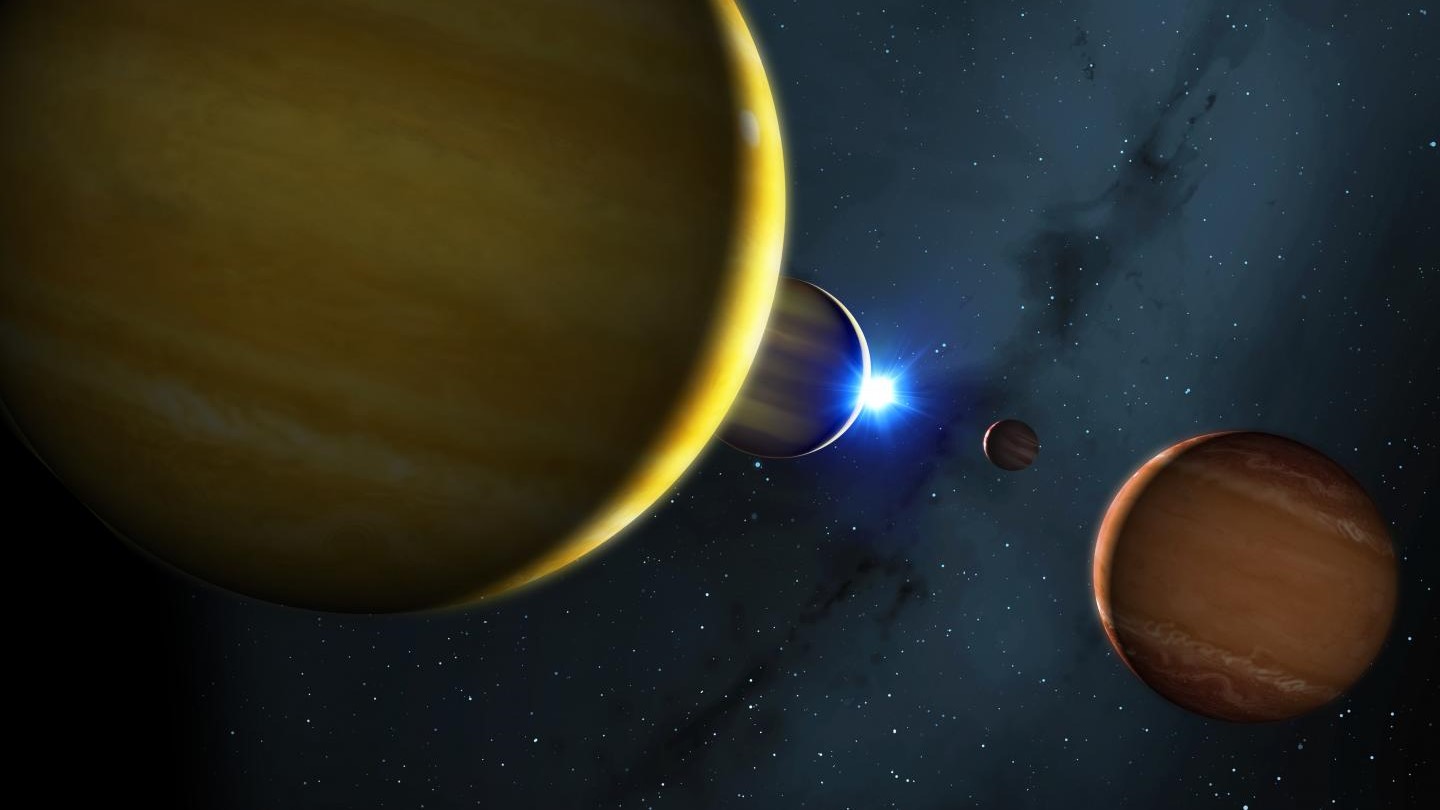When this star blows, its planets will be turned into enormous pinballs
The planets will one day be sent bouncing off each other's gravity.

Four planets in a nearby solar system could pinball off each other and careen off into outer space when the star they orbit dies, astronomers predict.
Those four planets are part of HR 8799, a system 135 light-years away from Earth in the constellation Pegasus. These planets, each of which weighs more than five times the mass of Jupiter, orbit a star that is 30 million to 40 million years old.
Right now, the closely-spaced planets are locked in a perfect rhythm, with each planet orbiting at twice the speed of the next outermost one — so that for every orbit the furthest planet completes, the next closest in will complete two, the one after that four, while the closest to the star completes eight.
But once their star becomes a red giant — ballooning to hundreds of times its original size — the hefty orbs will get flung out of the star's gravitational grip, according to a new study which modeled changes to the fine balance of the system's gravitational forces.
Related: 15 unforgettable images of stars
"The planets will gravitationally scatter off of one another," lead author Dmitri Veras, a physicist at the University of Warwick in England, said in a statement. "In one case, the innermost planet could be ejected from the system. Or, in another case, the third planet may be ejected. Or the second and fourth planets could switch positions. Any combination is possible just with little tweaks."
Understanding the gravitational interaction between two bodies is relatively simple once you know the objects' masses, velocities and starting positions. But add a third body and the simple solution immediately breaks down. The interactions become so complex that, as the French mathematician Henry Poincaré showed in 1899, no equation can predict the positions of all three bodies at all points in the future.
Sign up for the Live Science daily newsletter now
Get the world’s most fascinating discoveries delivered straight to your inbox.
Add in a fourth and then a fifth, as in the HR8799 star system, and the interactions are even more complex.To better understand how this game of planetary pinball might play out, the team created a computer model that enabled them to view the numerous, vastly different ways the planets could scatter chaotically after the researchers made only slight adjustments to the their starting positions.
"They are so big and so close to each other, the only thing that's keeping them in this perfect rhythm right now is the locations of their orbits," Veras said. "All four are connected in this chain. As soon as the star loses mass, their locations will deviate, then two of them will scatter off one another, causing a chain reaction amongst all four."
The team's model, alongside an estimate of the remaining time the star will spend in its current phase, predicts that the planets are likely to remain locked in their cosmic balancing act for the next 3 billion years — regardless of any disruptive effects from nearby star flybys or tidal forces caused by the movement of galaxies. But the show must end eventually. For this planetary system, that will happen when its star balloons into a red giant.
Stars are powered by the process of nuclear fusion — they combine hydrogen atoms to form helium and release an enormous amount of energy in turn. But when stars run out of hydrogen, the fusion reaction sputters out, and the sudden drop in activity cools the star’s plasma, lowering the thermal pressure and causing the star to be sucked in by its own weight.
This sudden decrease in size, in turn, reheats the star's core, enabling it to fuse heavier elements and causing it to balloon outward, expanding to several hundred times its original size. Over time, as the star runs out of heavier elements to fuse, it will shed its outer layers, leaving behind its bright white core — a white dwarf.
This red giant stage spells doom for HR 8799's pirouetting planets, which will be scattered in all directions, dislodging material from nearby debris disks — disks of dust and rock that orbit stars — into the star's atmosphere. This type of debris is of special interest to astronomers, as it could offer insights into the histories of many other white dwarf systems.
"These planets move around the white dwarf at different locations and can easily kick whatever debris is still there into the white dwarf, polluting it," Veras said. "The HR 8799 planetary system represents a foretaste of the polluted white dwarf systems that we see today. It's a demonstration of the value of computing the fates of planetary systems, rather than just looking at their formation."
The researchers published their findings May 14 in the journal Monthly Notices of the Royal Astronomical Society.
Originally published on Live Science

Ben Turner is a U.K. based staff writer at Live Science. He covers physics and astronomy, among other topics like tech and climate change. He graduated from University College London with a degree in particle physics before training as a journalist. When he's not writing, Ben enjoys reading literature, playing the guitar and embarrassing himself with chess.









